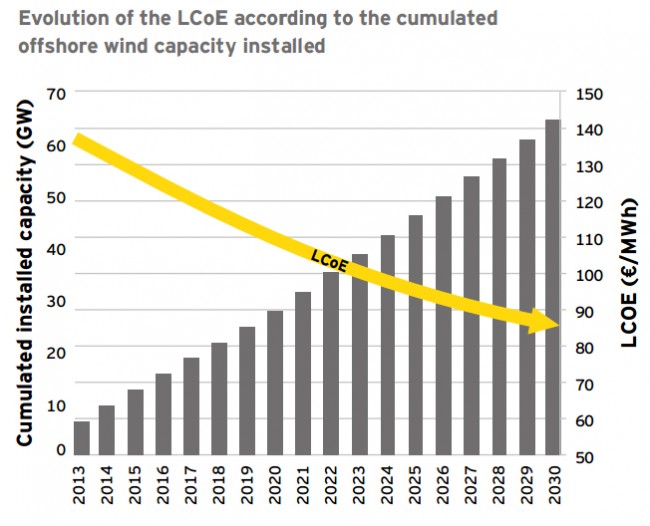
OVERVIEW
MANAGEMENT
PERFORMANCE
POSSIBILITIES
CAPITALS
ACTIVITIES
ACTORS
BURGESS
Energy |
|
Burgess COMMENTARY |
|
Offshore Wind is (Finally) Coming to the U.S. offshoreturbineEWEA On Monday, Deepwater Wind broke ground on what’s expected to be the first utility-scale offshore wind farm in U.S. waters. At a planned 30 megawatts, the Block Island Wind Farm project marks what the Sierra Club calls “a watershed moment for American clean energy development.” In addition to creating 300 local jobs and meeting the energy needs of all the residents of Block Island, the five wind turbines to be installed in Nantucket Sound off the Rhode Island coast are to be interconnected with a mainland grid via a new undersea cable. Deepwater Wind Block Island, a wholly-owned subsidiary of Deepwater Wind, completed financing for the offshore wind farm back in March, announcing that it had secured more than $290 million in project financing. The project is slated for completion in 2016. In September 2012 a Stanford University research team concluded that U.S. Atlantic coast offshore winds hold the potential to meet the electricity needs of no less than one-third the entire nation, or all that’s needed across the U.S. East Coast from Maine to Florida. Development of this vast clean renewable energy resource continues to be hindered by engineering and technical challenges, as well as by NIMBY and clean energy opponents despite development of an integrated, flexible ecosystems-based institutional framework and federal funding of R&D by the Obama administration. A “watershed moment” for U.S. offshore wind power The high up-front capital and retail costs of U.S. offshore wind power has been a persistent and pointed criticism from those opposed to government support. But project proponents say the Block Island Wind Farm will reduce electricity rates for New England residents by 40 percent.
Residents of Block Island rely on diesel generators for electricity. All of those will be replaced, and all the island’s electricity needs will be met upon completion of the offshore wind farm. More substantially, excess electricity will be sent onwards to National Grid‘s mainland power distribution network and supply renewable electricity to Rhode Island and other New England states. Moving “Beyond Coal” The Sierra Club has been drumming up support for the Block Island wind farm since the project was launched in 2009. “The importance of this day cannot be overstated,” Emily Norton, director of the Massachusetts Chapter of the Sierra Club, was quoted as saying. “The Block Island Wind Farm is our Apollo 11 moment. I am going to remember this day, and tell my kids and grandkids that I was there when the first U.S. offshore wind farm was built – that when we had a choice between bequeathing them a future powered by polluting fossil fuels that lead to extreme storms, heat waves and drought, we chose to power their future from the wind, and the sun, and smart technologies.” Sierra Club and other U.S. offshore wind power supporters see the Block Island Wind Farm project as “just the beginning of a burgeoning offshore wind industry in the United States.” “The Bureau of Ocean Energy Management has designated a wind management area off the coast of Rhode Island and Massachusetts that has the potential to generate as much as 9,000 megawatts” of wind power. If fully harnessed, that’s enough to “power 700,000 homes and create 43,000 offshore wind-related jobs on the east coast by 2030,” Sierra Club says. The U.S. has yet to see a single commercial offshore wind power project completed. With plans to install 130 wind turbines in Nantucket Sound off the coast of Cape Cod, Massachusetts, the more ambitious Cape Wind project looks as though it’s dead in the water. Criticized as poorly designed and conceived, Cape Wind in April 2010 garnered a $150 million promise of a federal loan from the Obama administration that was contingent on Cape Wind securing the $2.6 billion it projected was required to complete the project from private-sector sources. The European Union, in contrast, continues to forge ahead in developing offshore wind power potential. According to the European Wind Energy Agency (EWEA), 2,488 wind turbines spanning 74 offshore wind farms — with total renewable energy generation capacity of 8.045 megawatts — were connected to power grids across the EU as of year-end 2014. Development of offshore wind power potential in the U.S. dovetails with Sierra Club’s Beyond Coal campaign. “Moving beyond coal means more than just putting a stop to coal fired power; it means investing in America’s true clean energy promise,” Niles added. “Today, on Block Island, we again prove that America can be a leader in creating a clean energy reality that ensures every person can breathe clean air, enjoy clean water and live in a world free from the threat of climate disruption.” *Image credits: 1) European Wind Energy Agency 2) Edie.net ANDREW BURGER An independent journalist, researcher and writer, my work roams across the nexus where ecology, technology, political economy and sociology intersect and overlap. The lifelong quest for knowledge of the world and self -- not to mention gainful employment -- has led me near and far afield, from Europe, across the Asia-Pacific, Middle East and Africa and back home to the Americas. Twitter: @mightysparrow LinkedIn: andrew burger Google+: Andrew B Email: huginn.muggin@gmail.com FOLLOW ANDREW BURGER @MIGHTYSPARROW |
|
by Andrew Burger
on Tuesday, Apr 28th, 2015 |
| The text being discussed is available at http://www.triplepundit.com/2015/04/deepwater-wind-breaks-ground-offshore-wind-power-project/ and |
